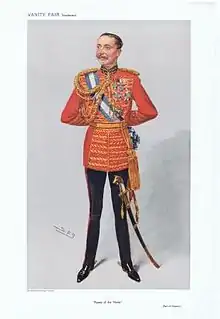List of Masters of the Horse
The following list contains many of the people that held the office of Master of the Horse in England. The list is not complete, because many of the earlier holders are unknown. The periods of service for some of the earlier holders are patchy, as well.

Earl of Granard as Master of the Horse, 1908
Masters of the Horse
14th and 15th centuries
- Sir John (de) Brocas, of Clewer. De facto Master of Horse to King Edward III. c.1360–1371
- Sir Bernard Brocas 1371–
- Sir Thomas de Murriex
- Thomas de Clifford, 6th Baron de Clifford 1388–1391
- Sir John Russell 1391–1398
- Richard Redman 1399–1399
- Robert Waterton 1399–1405
- John Waterton 1413–1416
- Sir Henry Noon
- Richard de Beauchamp, 13th Earl of Warwick
- Sir Walter Beauchamp 1429–1430
- Sir John Styward
- The Lord Beauchamp 1440–
- Sir Thomas de Burgh <1454–?1479
- Sir John Cheyne 1475–1487
- Sir Thomas Tyrrell 1483–1483
- Sir James Tyrell 1483–
16th century
- Sir Thomas Brandon c.1485–1510
- Sir Thomas Knyvet 1510–1512
- The Duke of Suffolk 1513–1515
- Sir Henry Guildford 1515–1522
- Sir Nicholas Carew 1522–1539
- Sir Anthony Browne 1539–1548
- The Earl of Pembroke 1548–1552
- The Earl of Warwick 1552–1553
- Sir Edward Hastings 1553–1556
- Sir Henry Jerningham 1556–1558
- Lord Robert Dudley 1558–1587, created Earl of Leicester in 1564
- The Earl of Essex 1587–1601
17th century
- The Earl of Worcester (c. 1601–1616)
- Sir George Villiers (1616–1628), created Duke of Buckingham in 1623
- Henry Rich, 1st Earl of Holland (1628)
- The Marquess of Hamilton (1628–c. 1644), created Duke of Hamilton in 1643
- Prince Rupert of the Rhine (1653–1655), in exile
- John Claypole (1653–?1660), appointed by Oliver Cromwell during the Commonwealth
- The Duke of Albemarle (1660–1668)
- The Duke of Buckingham (1668–1674)
- The Duke of Monmouth (1674–1679)
- In commission (1679–1681):
- The Duke of Richmond (1681–1685)
- Commissioners appointed during the Duke of Richmond's minority (1682–1685):
- Henry Guy
- Theophilus Oglethorpe
- Charles Adderley
- The Lord Dartmouth (1685–1689)
- Henry Overkirke (1689–1702)
18th century
- In commission (1702):
- Sir Stephen Fox
- Sir Benjamin Bathurst
- Hugh Chudleigh
- The Duke of Somerset (1702–1712)
- In commission (1712–1714):
- Conyers Darcy
- George Feilding
- The Duke of Somerset (1714–1715)
- In commission (1715–1717):
- In commission (1717–1727):
- The Earl of Scarbrough (1727–1735)
- The Duke of Richmond (1735–1750)
- vacant
- Marquess of Hartington (1751–1755)
- The Duke of Dorset (1755–1757)
- The Earl Gower (1757–1760)
- The Earl of Huntingdon (1760–1761)
- The Duke of Rutland (1761–1766)
- The Earl of Hertford (1766)
- The Duke of Ancaster and Kesteven (1766–1778)
- The Duke of Northumberland (1778–1780)
- The Duke of Montagu (1780–1790)
- The Duke of Montrose (1790–1795)
- The Earl of Westmorland (1795–1798)
- The Earl of Chesterfield (1798–1804)
19th century
- The Marquess of Hertford (1804–1806)
- The Earl of Carnarvon (1806–1807)
- The Duke of Montrose (1807–1821)
- The Duke of Dorset (1821–1827)
- The Duke of Leeds (1827–1830)
- The Earl of Albemarle (1830–1834)
- The Duke of Dorset (1835)
- The Earl of Albemarle (1835–1841)
- The Earl of Jersey (1841–1846)
- The Duke of Norfolk (1846–1852)
- The Earl of Jersey (1852)
- The Duke of Wellington (1853–1858)
- The Duke of Beaufort (1858–1859)
- The Marquess of Ailesbury (1859–1866)
- The Duke of Beaufort (1866–1868)
- The Marquess of Ailesbury (1868–1874)
- The Earl of Bradford (1874–1880)
- The Duke of Westminster (1880–1885)
- The Earl of Bradford (1885–1886)
- The Earl of Cork (1886)
- The Duke of Portland (1886–1892)
- The Viscount Oxenbridge (1892–1894)
- The Earl of Cork (1894–1895)
- The Duke of Portland (1895–1905)
20th century
_(Baron_Vestey_cropped).jpg.webp)
Lord Vestey as Master of the Horse in 2018
- The Earl of Sefton (1905–1907)
- The Earl of Granard (1907–1915)
- The Earl of Chesterfield (1915–1922)
- The Marquess of Bath (1922–1924)[1][2]
- The Earl of Granard (1924–1936)[3][4]
- The Duke of Beaufort (1936–1978)
- The Earl of Westmorland (1978–1991)[5]
- The Lord Somerleyton (1991–1999)[6]
- The Lord Vestey (1999–2018)[7]
21st century
- The Lord de Mauley (2019–present)[8]
References
- "No. 32775". The London Gazette. 8 December 1922. p. 8702.
- "No. 32775". The London Gazette. 8 December 1922. p. 8698.
- "No. 32909". The London Gazette. 19 February 1924. p. 1453.
- "No. 32914". The London Gazette. 29 February 1924. p. 1819.
- "No. 47478". The London Gazette. 3 March 1978. p. 2771.
- "No. 52686". The London Gazette. 15 October 1991. p. 15641.
- "No. 55368". The London Gazette. 7 January 1999. p. 159.
- "Appendix To Court Circular". Court Circular. 26 July 2018. Retrieved 28 July 2018.
- Bibliography
- Reese, Max M. (1976). The Royal Office of Master of the Horse. London: Threshold Books Ltd.
- Bucholz, R. O. (2006). "The stables: Master of the Horse 1660–1837". Office-Holders in Modern Britain: Volume 11 (revised): Court Officers, 1660–1837. pp. 603–04.
- The Seaxe Newsletter of the Middlesex Heraldry Society, Feb 2007
This article is issued from Wikipedia. The text is licensed under Creative Commons - Attribution - Sharealike. Additional terms may apply for the media files.
